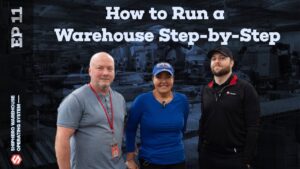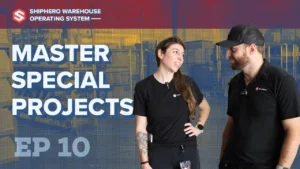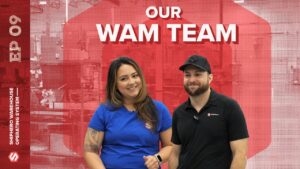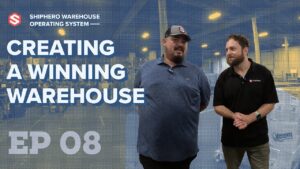Video Transcript
Hello, everyone.
This is Val from ShipHero.
I'm here today at our
Palm Beach warehouse.
In this warehouse we do a
lot of prekitting, assembly,
FBA prep,
and I'm very excited to show
you a feature we have out
called Work Orders
that will make this whole
process a lot easier.
With our Work Orders feature,
you'll be able to upload a work order
with instructions, attachments, images.
You'll be able to print out
barcodes for your custom SKU,
your assembly SKU.
You'll be able to track
every step of your process
through your timeline.
You'll also be able to charge your clients
straight through Work
Orders with 3PL Billing.
All right, now let's take a look
at what this feature
looks like in ShipHero.
All right, let's take a look
at creating a work order.
As you'll see here, we are
on our Work Order dashboard.
From this page, you see a
lot of useful information.
You'll see any of your existing
Work Orders, the warehouse.
If you have multiple 3PLs,
you'll see which 3PL was assigned.
You'll see the type of work order.
For this version, we support
two types of Work Orders,
an assembly work order
which is creating your
kits, your FBA prep stock.
We also offer a custom work order,
which I'll show you later on in this demo,
which allows for an
uploading of instructions.
It's pretty much a blank slate,
allowing you to submit a request.
You also see here the Requested date,
the date that you would like
this work order completed by;
the Scheduled date, which
is when the warehouse
is set to work on this work order.
This is great internally
for working through a queue
and determining which Work
Orders you want to start and when
and dividing up your workforce
in order to complete that task.
You'll also see, very
quickly, the order status.
You'll see which ones are in progress,
which Work Orders are being picked,
which ones are being assembled,
as well as anything that
is completed or canceled.
Over in the Actions item,
you'll see there's different icons.
The first icon shows you
when the work order was being picked,
the next one when it was being assembled,
and then when it was being completed.
We support filters for the order status,
so if you only want to see Work
Orders that are in progress,
that are active,
you can set your filters
to only show in progress
Work Orders and hit Apply.
And as you'll see,
the canceled one is removed from the view.
All right, now let's take a look
at now creating a new work order.
On the top right of your screen,
there is a Create work order option,
which will lead you to
a very straightforward
step-by-step guide of
creating your work order.
If you are a 3PL,
Work Orders are created
on the client level.
The reason being is clients
generally submit these
Work Orders to their 3PL
for the work that they need done.
If you're a brand account,
you would create your own Work Orders
and this first step would be omitted.
In this demo, we're taking
a look at the 3PL flow.
So in this case, I'm the client,
and I'm gonna be submitting
a work order to my warehouse
for some SKU that I need built.
So first, I'll choose which 3PL
I would like to work on this work order,
then which warehouse I would
like them built out of,
and then the requested date.
So for example, if this
work order was needed
for a restock at a big retailer
by the end of the month,
I would want all of these assembled
before that end of the month.
After choosing your requested date,
you'll be able to select Continue,
and it'll ask you for a work order name,
as well as a work order type.
For this example, we're
going to take a look
at an FBA prep work order.
This is an assembly work order type
because we're going to be
putting together these SKUs
for the FBA.
After naming your work order
and choosing your work
order type, select Continue.
This will bring you to
your Select item page.
When you choose this Select kit option,
you will see your different assembly kits.
Each work order can have one assembly kit.
When you expand each kit,
you'll see the different
components needed for this SKU,
as well as their on hand.
For this example,
we're going to build the
first assembly SKU on top,
so I'll select that, hit Select.
Then I'll be asked how many of
these I would like to create.
You'll be able to see your on hand,
which will give you a good
guide on how many you can build.
For this example,
we're going to build 100 of these SKU.
There's an optional configuration.
This can be, for example, one body wash,
one face wash per kit.
This will also be
visible on the next page,
but it's a good option for a note
if you need any sort of
special configuration
for this work order.
After hitting Continue,
you'll be prompted for
additional instructions.
These can be packing details,
as well as specific assembly details.
Packing details can be
including filler paper
or special tape.
Assembly can be as detailed
as you would like it to be
or these fields can also remain blank.
We'll type in an example together, though.
(gentle upbeat music)
If typing's not really your style,
as you'll see on the next page,
you can also upload attachments.
This is great, especially
if this is a work order
that you may do more than once.
You can have all of the
instructions saved in a file.
You can have a PDF with pictures
of how you would like this assembled.
You can upload a picture
of the box assembled
as a reference of what it
should look like when it's done.
You can upload labels,
or a special barcode,
or an extra insert.
Anything that you may
need for this work order,
you can add as an attachment here.
Don't worry if you forget any,
you can add attachments again later,
which I will show you later in our demo,
but this is a great option
to upload those instructions
that you don't need to type
them out in the earlier stage.
When you're done, select
Create work order.
This will send your
work order to your 3PL.
Your 3PL will then be able to review it
and then determine if this is something
that they are going to assemble.
So hit Create work order.
Work order created.
All right.
Now, we're gonna move
forward to the 3PL side.
Okay, we are now in our 3PL account.
This is what your
warehouse manager will see.
When they come in, they'll
see their Work Orders,
they'll see the statuses,
and anything that's new, and
as it's awaiting approval,
will also be highlighted.
The work order that we
just created previously
is this one down here
for our FBA prep restock.
As you can see, it's awaiting approval
with a requested date at
the end of this month.
So we're gonna click into that.
(gentle upbeat music)
From here, you're gonna get an
overview of your work order.
You'll see what they are
requesting, how many kits,
the kit requirements,
how many of each component
per kit is visible.
You'll see any instructions
that they included,
as well as any attachments.
You'll see the timeline
for when this work order was created.
You'll see the requested date.
And as you can see here,
you can also add your own attachments.
After reviewing,
if this is something that your warehouse
as the time in the workforce
that they can tackle it,
you can mark it as in progress,
meaning you've approved this work order.
When you mark it as in progress,
you have the option to leave a note.
This could be as simple as
just saying that it's approved
and putting the name.
Everything is tracked in the timeline,
so this is an optional field,
but feel free to leave as many
or as few notes as you would like.
(gentle upbeat music)
All right, so this is now in progress.
Now, we realize Work Orders
aren't always done right away.
This is requested for
the end of the month.
Based on your workforce, though,
you might not be able
to start working on this
for a few more days.
That's why we have a
Scheduled date option here.
This Scheduled date is
the date that your team
can start working on this work order.
This is an internal date for
you to be able to prioritize
when you wanna work on
different Work Orders.
It's very common that you're gonna have
a lot of Work Orders requests coming in
from different customers
that need an FBA stock,
they want a kit assembled,
so you need a way to queue these up.
The Scheduled date will help you do that.
So for this example, we'll
set our scheduled date.
Hit Save.
You'll be able to assign pickers,
as well as your packers,
to track who is working
on this work order.
As you see here, we have an
option to add ad hoc charges.
If you're a 3PL, this is
gonna be a game-changer.
Here, you're able to add a charge
to bill your client for this work.
When you hit Add new charge,
you'll see that we have
a few options here.
You can bill per hour.
You can bill per unit.
This can be of the different
components that you picked
or the final assembly SKU.
You can also put a bill
for the whole work order.
If we choose per hour,
you can track how many men hours
you spent working on this work order,
as well as the rate.
You can also add multiple charges,
so you can bill per hour
as well as per unit.
(gentle upbeat music)
And when your work order is complete,
this will automatically
sync to 3PL Billing,
and you can charge your client.
Going back to the main screen
just to show the Scheduled date portion.
When you are prioritizing
which ones you would like to work on,
you can see which of your
scheduled dates is coming up
and which work order
you would like to start.
We're gonna continue with our example.
So let's say it's the next day
and we are ready to pick this.
We're going to now mark this
work order as ready to pick.
Again, you can add a note.
This is optional.
But a good note example could be starting,
picking, or ready to move.
All right, this is now in
your Ready to pick status.
The next step is to choose
which location or locations
that you would like to
pick your components from.
Over in this section,
you'll see it says Assign.
When you click Assign,
you'll see all the locations
that this component existed.
Choose which location or locations
that you would like to pick from.
Hit Add,
and complete this process for
the rest of your components,
(gentle music)
and hit Save.
Your To create quantity is set.
However, we understand things happen.
You may have a case where maybe
you need to create some more
or maybe the inventory wasn't
what you thought it was
and you need to create less.
This, at this stage, your
To create can be edited,
in which case your pick quantity
will automatically be adjusted as well.
(gentle upbeat music)
You also want to choose
a staging location,
so this is part of our work order feature
and we think this will really streamline
a lot of the process.
What we'll do here is we're
going to pick each component
and then we're going to move everything
to our new staging area.
This is all done within ShipHero.
All the inventory
movements will be tracked,
inventory will be deducted
from the locations that it's picked from,
and it will be moved to
the new staging location.
So let's choose a staging location.
This location could be any
location in your warehouse,
though we generally suggest
that it is a not pickable location.
All right.
We've selected our staging, our locations,
our on hand is good,
our amount in location.
A thing to note about
the In location here.
This is taking into account allocations.
Generally, large Work Orders
will be picked from a non-pickable bin,
which is supported.
So other orders shouldn't
really be allocated,
but in the event there
are other allocations,
the in location, we'll
take that into account
and deduct that amount
so you're not picking things
that are already allocated
to another order.
Next, you're gonna wanna
print your picking sheet.
Here, you'll see your picking list,
your location to pick from,
your lot codes, your quantity,
as well as a start time,
and then off your team will go
to go grab all of these items
and move them over to staging.
This can be edited at this
point, again, at any time.
In case while they're at that location,
you need to switch the location,
you can still do that.
And you can reprint your
pick sheet as needed.
Once everything is on hand,
you're going to want to mark
this as Assembly in progress.
This is a big step
because this is what's
gonna tell ShipHero,
"We are deducting the
amount that you picked,
the 100 from each of these locations,
and we are now moving all of this
to the new staging location."
Once you've picked your components,
you're now gonna move this work order
to Assembly in progress.
This step is gonna deduct what you picked,
so 100 of each of these components
from the locations that you chose,
and move it to your new staging area.
So I'll be moving my
body wash, my face wash,
as well as my bags into
our Project_Staging_2.
This location is not
replenishable, not pickable,
and not sellable.
All right, we'll hit Mark as assembly.
Again, an optional note option.
(gentle upbeat music)
All right, as you can see,
there's some changes now.
At this point, the
inventory has been moved,
so everything here is
now in your staging area.
In the event that you
need to put things back,
it would be a process using our putaway,
which is a separate feature.
But for now, everything is in staging.
Your team will go to your staging area
and start to build these assembly SKUs.
This is where the work
outside ShipHero picks up
because they're going to
need to take their body wash,
their face wash, put
everything in the bag,
and following the instructions.
The team can download their attachments
for any of the images they need to see.
They can print out any sort
of insert that they would need
and they'll start putting these together.
As they complete their kits,
you will come into the system
and you can mark as many
as that has been built.
You don't need to build them all at once.
We realized this can take time.
If you have to build thousands of kits,
it may take you a week
to build all of these.
So as you finish each
of your assembly kits,
you'll mark how many were done,
and then you can transfer
them to a receiving area.
So this receiving area,
you have a lot of options.
One use case could make this
like a transfer location,
like a cart,
in which case you'll take
your now completed SKU,
put them there,
and then you can go put them
away into pickable locations.
This receiving area can be
the pickable location directly
if you just wanna go drop these off
where they can be picked.
Once these are received,
you can start selling them,
you can start fulfilling orders.
This SKU is done.
What will happen is each of the components
will be deducted from ShipHero
out of the staging area all automatically,
and then your completed
assembly SKU quantity
will increase by the
amount sheet input here.
So for our receiving area,
we're just going to use
a receiving location.
Hit Save
and hit Transfer to.
This is going to move your
completed assembly SKU
and do the transfer for you.
All right, as you'll see here,
five of our 100 kits have been built.
Obviously, a new kit is
going to need a barcode
that can all be done from the screen.
You hit Print barcodes up on top,
choose how many barcodes you
would like, and hit Prints.
Now you can barcode your assembly SKU
and get those out the door.
From this screen, you are
still able to make edits.
For example, if this work order
was taking more time than you thought
or the assembly was more complex
and you wanted to add additional charges,
you're still able to do
that from this screen.
Everything is being tracked.
When we receive those five,
it shows in the timeline.
And you're able to make modifications
to your date, your pickers,
and your packers as needed.
Once you're done with all
of your assembly kits,
you can mark your work order as Done.
Once you have all done,
you'll see that your counter turns green,
meaning your work is done.
You also see you'll no longer
able to do any more transfers
because we've completed
all of our components
in the staging area
and we've finished our work order.
At this point, simply hit Mark as done.
You could leave a note,
say maybe QA approved
or a manager signed off
that the work was done
and hit Mark as done.
Your work order will now show as Complete.
That was creating a work
order on the client end,
as well as receiving
and building our Work
Orders on the 3PL end.
If you have any questions
or need any additional
information on Work Orders,
please check out our knowledge base.
(gentle upbeat music)



